Half-Wave Phase Shift Modulation for Hybrid Modular Multilevel Converter with Wide-Range Operation
Abstract
:1. Introduction
2. Topology and Operation Principle of HAMC
2.1. Topology Description
2.2. Operation Principle
3. Energy Balancing Analysis and Control of HAMC
3.1. Energy Balancing Analysis
3.2. Energy Balancing Control with Harmonic Injected Method
4. The HPSM Strategy of HAMC with Wide Operation
5. Simulation Results of HAMC
5.1. Steady State Characteristics
5.2. Dynamic Characteristics
- (1)
- The voltage modulation ratio m is set to drop by 20% at 0.2 s, and the voltage modulation ratio m is recovered at 0.6 s.
- (2)
- The load resistance is set to increase by 25% at 1.0 s, and the load resistance is restored to its original value at 1.4 s.
5.3. Performance Comparison with THCI
6. Experimental Validations of HAMC
7. Conclusions
- (1)
- Taking the compact HAMC topology as an example, the proposed HPSM strategy can ensure energy balance of the arm with a wide-range modulation ratio and enable the converter with voltage regulation capability.
- (2)
- With the HPSM strategy, simulated results show that the HAMC can achieve similar power quality, full-range voltage regulation, capacitor voltage, and dynamic response with the conventional MMC.
- (3)
- Performance comparison illustrated that the HPSM reduces operating loss by 50% compared to the THCI method, while no additional hardware is required.
Author Contributions
Funding
Data Availability Statement
Conflicts of Interest
Nomenclature
| HAMC | Half-wave alternating multilevel converter |
| SM | Submodule |
| M | Voltage modulation ratio |
| Fa | Switching function |
| uxm | Multiplexed arm voltage (x = a, b, c) (V) |
| ixm | Multiplexed arm current (x = a, b, c) (A) |
| ux | AC phase voltage (x = a, b, c) (V) |
| ix | AC phase current (x = a, b, c) (A) |
| Udc | DC voltage (V) |
| Um | Fundamental frequency amplitudes of the AC phase voltage (V) |
| Im | Fundamental frequency amplitudes of the AC phase current (A) |
| ∆Eam | Multiplexing arm energy accumulation |
| φ | Power factor angle |
| U3m | Triple frequency amplitudes of the AC phase voltage (V) |
| I3m | Triple frequency amplitudes of the AC phase current (A) |
| θ | Third-order harmonic phase |
| λ | Ratio of the third-order harmonic current to the fundamental amplitude |
| i0 | Third-order harmonic injection current (A) |
| η | Phase shift angle |
References
- Dekka, A.; Wu, B.; Fuentes, R.L.; Perez, M.; Zargari, N.R. Evolution of Topologies, Modeling, Control Schemes, and Applications of Modular Multilevel Converters. IEEE J. Emerg. Sel. Top. Power Electron. 2017, 5, 1631–1656. [Google Scholar] [CrossRef]
- Nami, A.; Liang, J.; Dijkhuizen, F.; Demetriades, G.D. Modular Multilevel Converters for HVDC Applications: Review on Converter Cells and Functionalities. IEEE Trans. Power Electron. 2015, 30, 18–36. [Google Scholar] [CrossRef]
- Debnath, S.; Qin, J.; Bahrani, B.; Saeedifard, M.; Barbosa, P. Operation, Control, and Applications of the Modular Multilevel Converter: A Review. IEEE Trans. Power Electron. 2015, 30, 37–53. [Google Scholar] [CrossRef]
- Rao, H.; Zhou, Y.; Zou, C.; Xu, S.; Li, Y.; Yang, L.; Huang, W. Design Aspects of Hybrid HVDC System. CSEE J. Power Energy Syst. 2021, 7, 644–653. [Google Scholar] [CrossRef]
- Lin, Z.; Qin, J.; Ma, H.; Liu, J.; Yang, B.; Wang, Y. Design of 500kV Hybrid HVDC Circuit Breaker Control and Protection System. In Proceedings of the 2020 4th International Conference on HVDC (HVDC), Xi’an, China, 6–9 November 2020; pp. 134–139. [Google Scholar]
- Yun, H.-J.; Jeong, D.-K.; Kim, H.-S.; Kim, M.; Baek, J.-W.; Kim, J.-Y.; Kim, H.-J. Implementation of a Single-Phase SST for the Interface between a 13.2 kV MVAC Network and a 750 V Bipolar DC Distribution. Electronics 2018, 7, 62. [Google Scholar] [CrossRef]
- Cervero, D.; Fotopoulou, M.; Muñoz-Cruzado, J.; Rakopoulos, D.; Stergiopoulos, F.; Nikolopoulos, N.; Voutetakis, S.; Sanz, J.F. Solid State Transformers: A Critical Review of Projects with Relevant Prototypes and Demonstrators. Electronics 2023, 12, 931. [Google Scholar] [CrossRef]
- Ma, F.; Kuang, Y.; Wang, Z.; Huang, G.; Kuang, D.; Zhang, C. Multi-Port and -Functional Power Conditioner and Its Control Strategy with Renewable Energy Access for a Railway Traction System. Energies 2021, 14, 6146. [Google Scholar] [CrossRef]
- Chen, J.; Hu, H.; Wang, M.; Ge, Y.; Wang, K.; Huang, Y.; Yang, K.; He, Z.; Xu, Z.; Li, Y.R. Power Flow Control-Based Regenerative Braking Energy Utilization in AC Electrified Railways: Review and Future Trends. IEEE Trans. Intell. Transp. Syst. 2024, 25, 6345–6365. [Google Scholar] [CrossRef]
- Oliveira, R.; Yazdani, A. An Enhanced Steady-State Model and Capacitor Sizing Method for Modular Multilevel Converters for HVdc Applications. IEEE Trans. Power Electron. 2018, 33, 4756–4771. [Google Scholar] [CrossRef]
- Xue, Y.; Xu, Z.; Tu, Q. Modulation and Control for a New Hybrid Cascaded Multilevel Converter With DC Blocking Capability. IEEE Trans. Power Deliv. 2012, 27, 2227–2237. [Google Scholar] [CrossRef]
- Merlin, M.M.C.; Green, T.C.; Mitcheson, P.D.; Trainer, D.R.; Critchley, D.R.; Crookes, R.W. A New Hybrid Multi-Level Voltage-Source Converter with DC Fault Blocking Capability. In Proceedings of the 9th IET International Conference on AC and DC Power Transmission (ACDC 2010), London, UK, 19–21 October 2010; pp. 1–5. [Google Scholar]
- Merlin, M.M.C.; Green, T.C.; Mitcheson, P.D.; Trainer, D.R.; Critchley, R.; Crookes, W.; Hassan, F. The Alternate Arm Converter: A New Hybrid Multilevel Converter With DC-Fault Blocking Capability. IEEE Trans. Power Deliv. 2014, 29, 310–317. [Google Scholar] [CrossRef]
- Wang, Y.; Li, Y.; Wang, C.; Zhang, Z. A Lightweight Hybrid Modular Multilevel Converter Topology for DC Fault Blocking. IEEE J. Emerg. Sel. Top. Power Electron. 2023, 11, 4945–4955. [Google Scholar] [CrossRef]
- Hassan, Z.; Watson, A.J.; Tardelli, F.; Clare, J. A Switched Mid-Point Modular Multilevel Converter for HVDC Applications. IEEE Trans. Power Deliv. 2023, 38, 1534–1547. [Google Scholar] [CrossRef]
- Wang, Y.; Zhang, Z.; Xu, Y.; Gao, Y.; Xu, L.; Xu, X. Topology and Control of an Arm Multiplexing MMC with Full-Range Voltage Regulation. IEEE Trans. Power Electron. 2024, 1–17. [Google Scholar] [CrossRef]
- Yu, Y.; Gao, Y.; Wang, Y.; Li, Y.; Su, Z.; Wang, R. A Half-Wave Alternating Multilevel Converter with High Submodule Utilization. In Proceedings of the IECON 2023—49th Annual Conference of the IEEE Industrial Electronics Society, Singapore, 16–20 October 2023; pp. 1–6. [Google Scholar]
- Merlin, M.M.C.; Green, T.C.; Mitcheson, P.D.; Moreno, F.J.; Dyke, K.J.; Trainer, D.R. Cell Capacitor Sizing in Modular Multilevel Converters and Hybrid Topologies. In Proceedings of the 2014 16th European Conference on Power Electronics and Applications, Lappeenranta, Finland, 26–28 August 2014; pp. 1–10. [Google Scholar]
- Merlin, M.M.C.; Judge, P.D.; Green, T.C.; Mitcheson, P.D.; Moreno, F.; Dyke, K. Alternate Arm Converter Operation of the Modular Multilevel Converter. In Proceedings of the 2014 IEEE Energy Conversion Congress and Exposition (ECCE), Pittsburgh, PA, USA, 14–18 September 2014; pp. 1924–1930. [Google Scholar]
- Farr, E.M.; Feldman, R.; Clare, J.C.; Watson, A.J.; Wheeler, P.W. The Alternate Arm Converter (AAC)—“Short-Overlap” Mode Operation—Analysis and Design Parameter Selection. IEEE Trans. Power Electron. 2018, 33, 5641–5659. [Google Scholar] [CrossRef]
- Merlin, M.M.C.; Soto-Sanchez, D.; Judge, P.D.; Chaffey, G.; Clemow, P.; Green, T.C.; Trainer, D.R.; Dyke, K.J. The Extended Overlap Alternate Arm Converter: A Voltage-Source Converter With DC Fault Ride-Through Capability and a Compact Design. IEEE Trans. Power Electron. 2018, 33, 3898–3910. [Google Scholar] [CrossRef]
- Moreno, F.J.; Merlin, M.M.C.; Trainer, D.R.; Dyke, K.J.; Green, T.C. Control of an Alternate Arm Converter Connected to a Star Transformer. In Proceedings of the 2014 16th European Conference on Power Electronics and Applications, Lappeenranta, Finland, 26–28 August 2014; pp. 1–10. [Google Scholar]
- Mathew, E.C.; Shukla, A. A Novel Submodule Capacitor Voltage Balancing Scheme for Hybrid Cascaded Multilevel Converter by Injection of Zero Sequence Current. In Proceedings of the IECON 2014—40th Annual Conference of the IEEE Industrial Electronics Society, Dallas, TX, USA, 29 October–1 November 2014; pp. 4534–4540. [Google Scholar]
- Huang, M.; Li, W.; Zou, J.; Ma, X. Analysis and Design of a Novel Hybrid Modular Multilevel Converter With Time-Sharing Alternative Arm Converter. IEEE Trans. Ind. Electron. 2024, 71, 14–26. [Google Scholar] [CrossRef]
- Hou, N.; Li, Y.W. Overview and Comparison of Modulation and Control Strategies for a Nonresonant Single-Phase Dual-Active-Bridge DC–DC Converter. IEEE Trans. Power Electron. 2020, 35, 3148–3172. [Google Scholar] [CrossRef]
- Bu, Q.; Wen, H.; Shi, H.; Zhu, Y. A Comparative Review of High-Frequency Transient DC Bias Current Mitigation Strategies in Dual-Active-Bridge DC–DC Converters Under Phase-Shift Modulations. IEEE Trans. Ind. Appl. 2022, 58, 2166–2182. [Google Scholar] [CrossRef]
- Zhang, Z.; Xu, Z.; Xue, Y. Valve Losses Evaluation Based on Piecewise Analytical Method for MMC–HVDC Links. IEEE Trans. Power Deliv. 2014, 29, 1354–1362. [Google Scholar] [CrossRef]
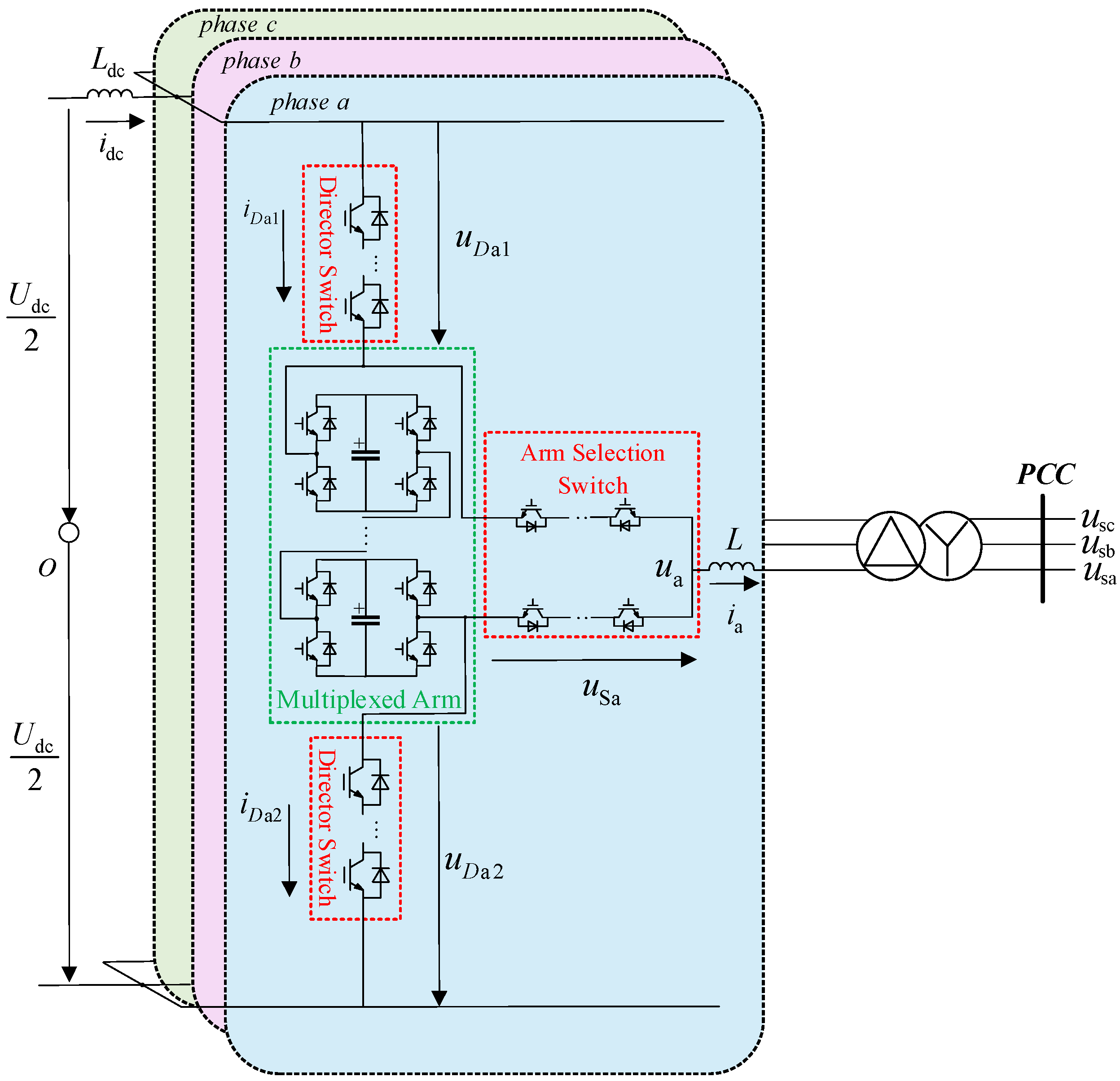
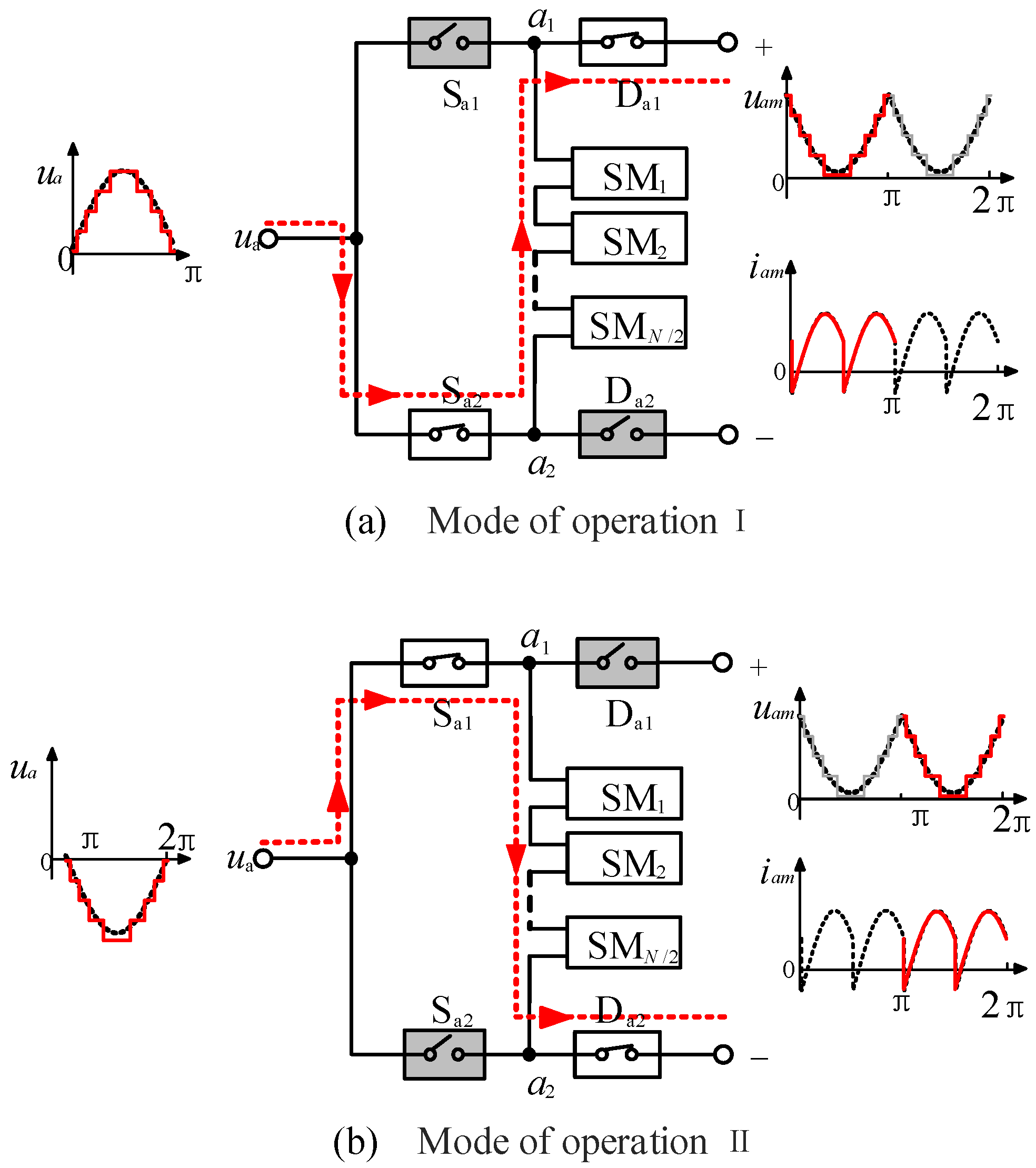
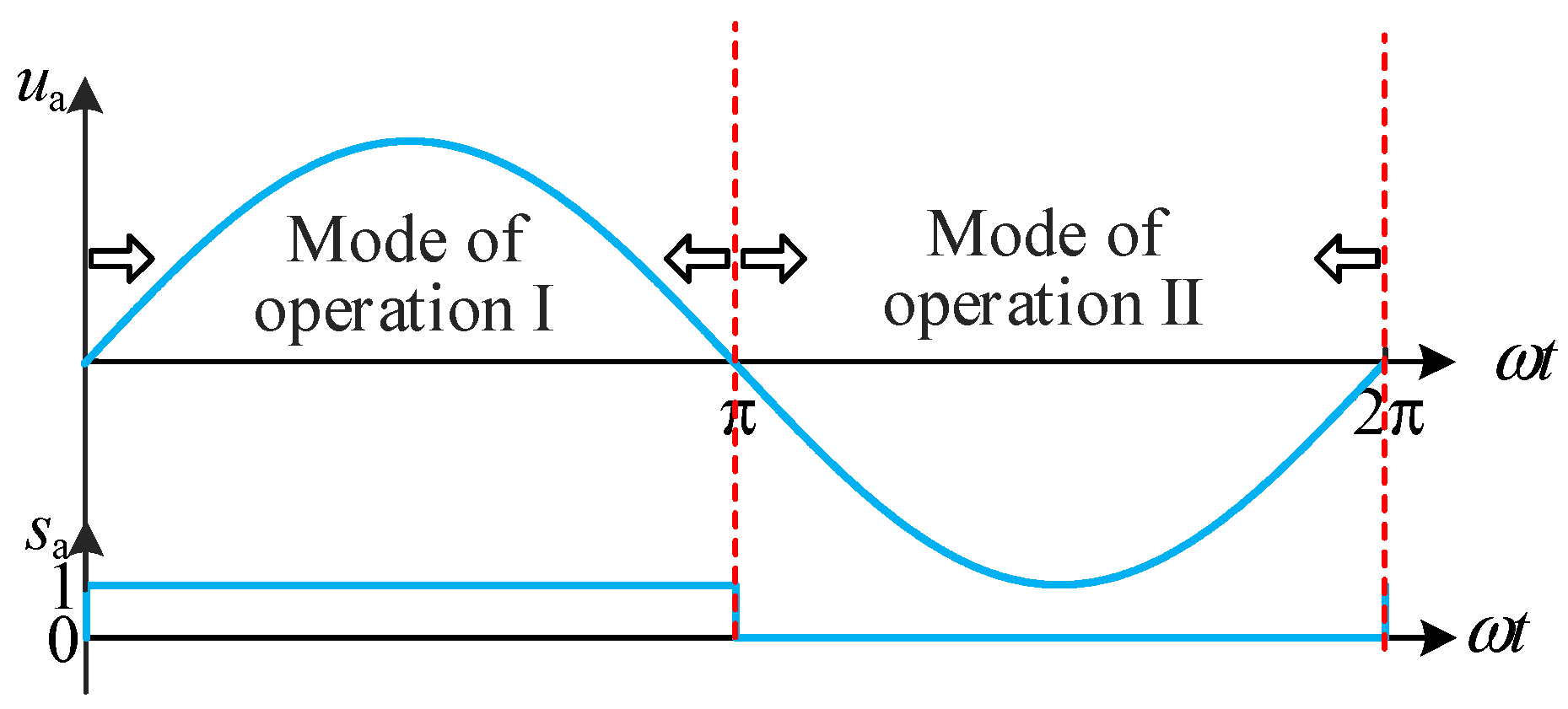

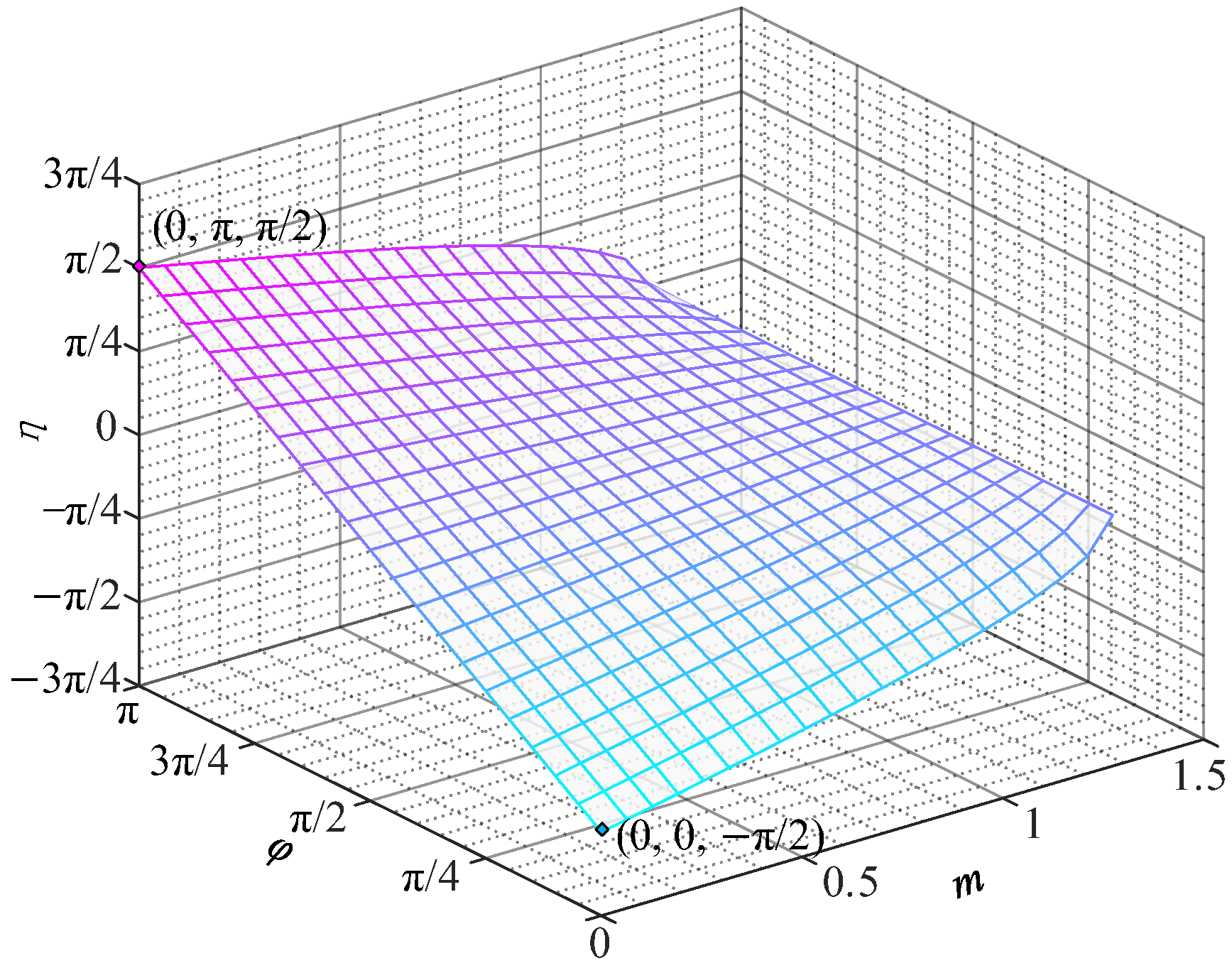
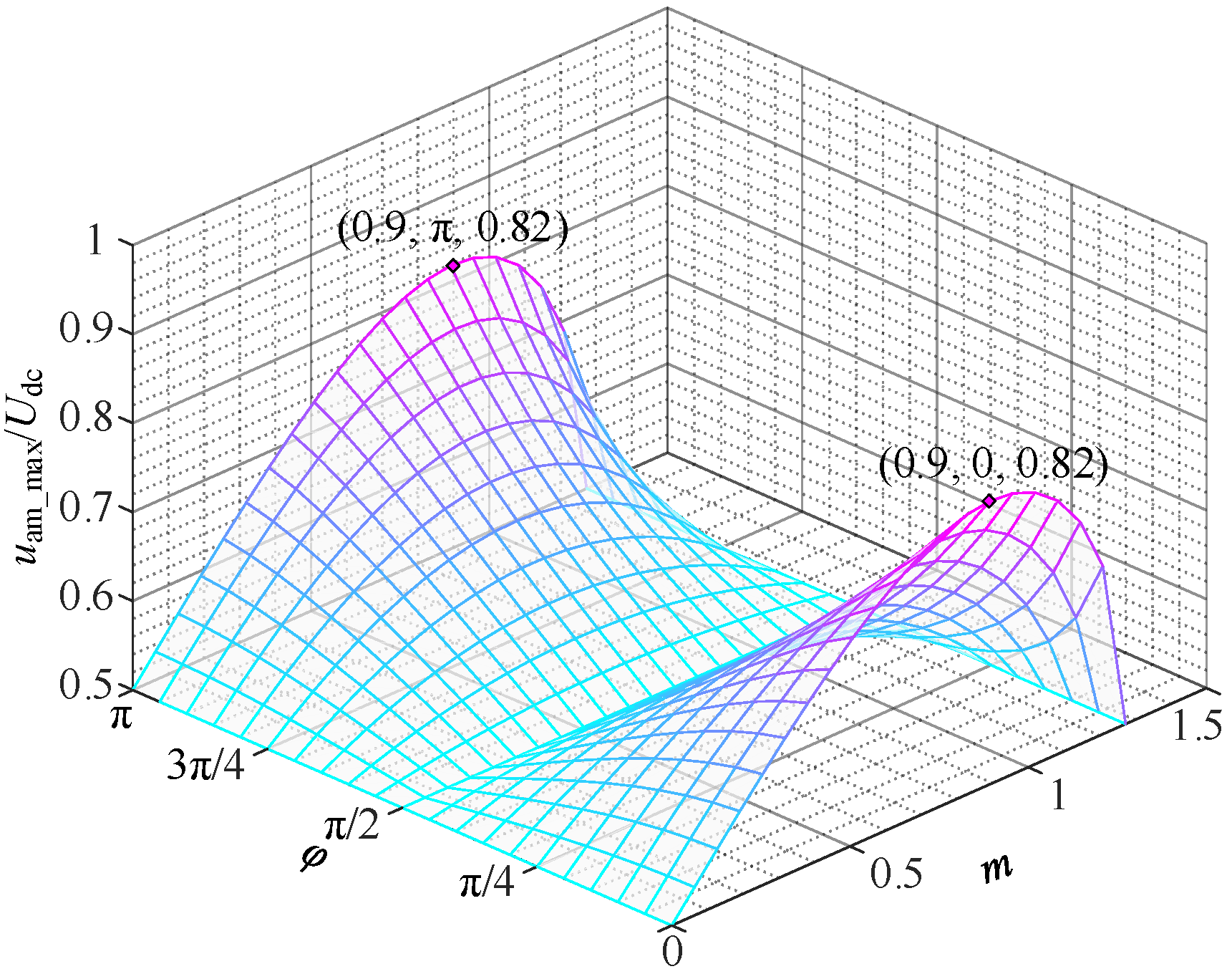

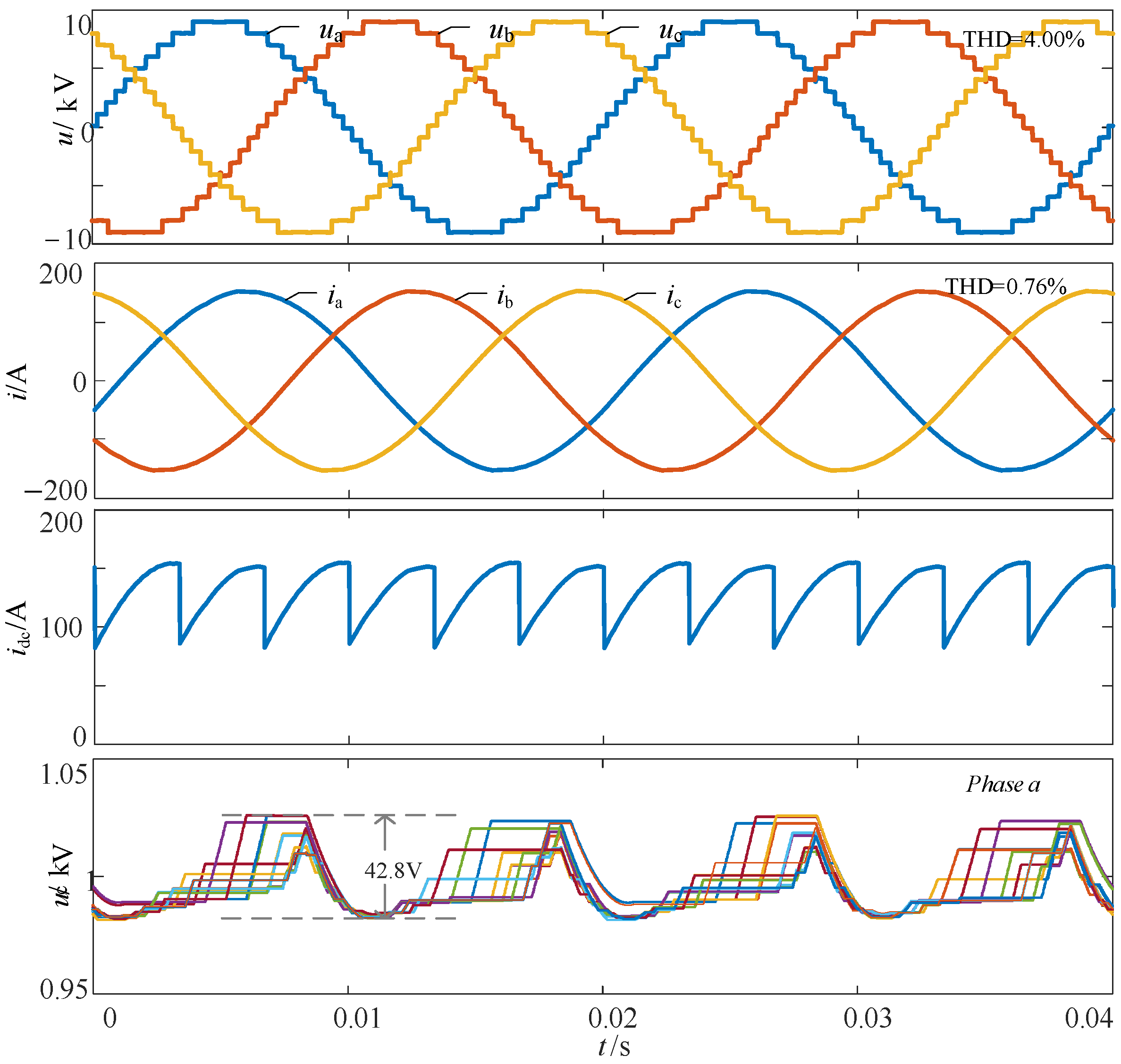
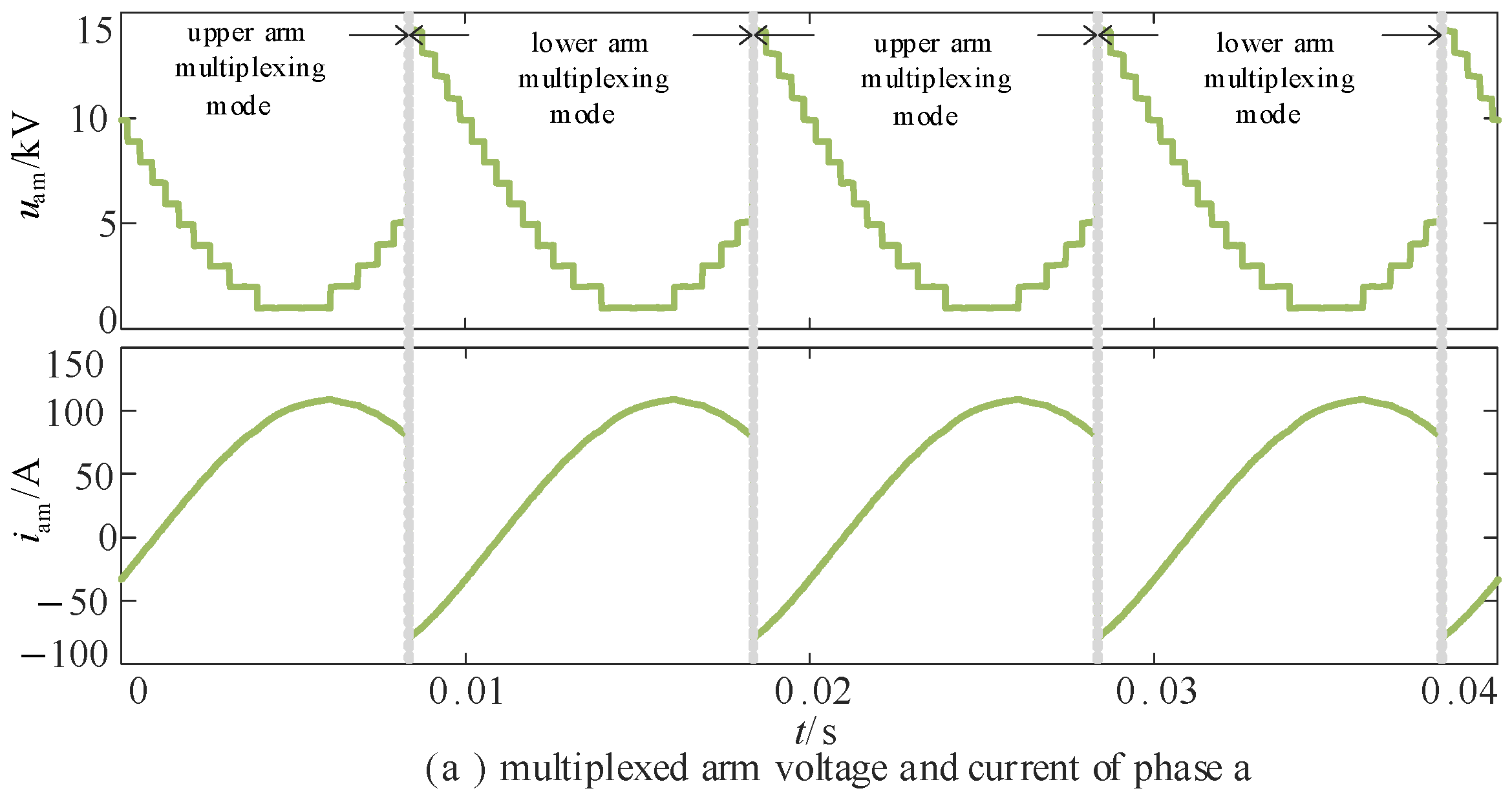
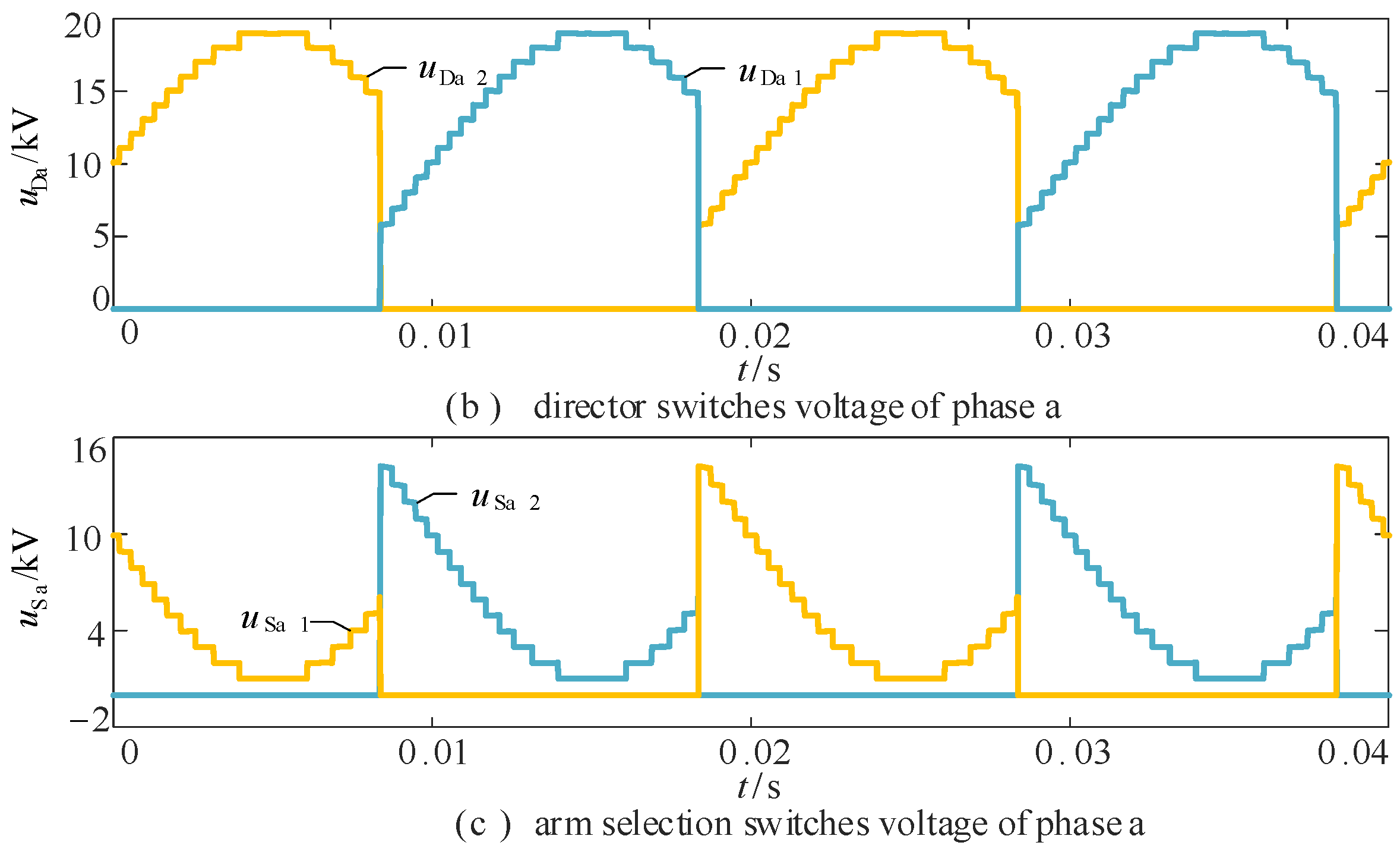
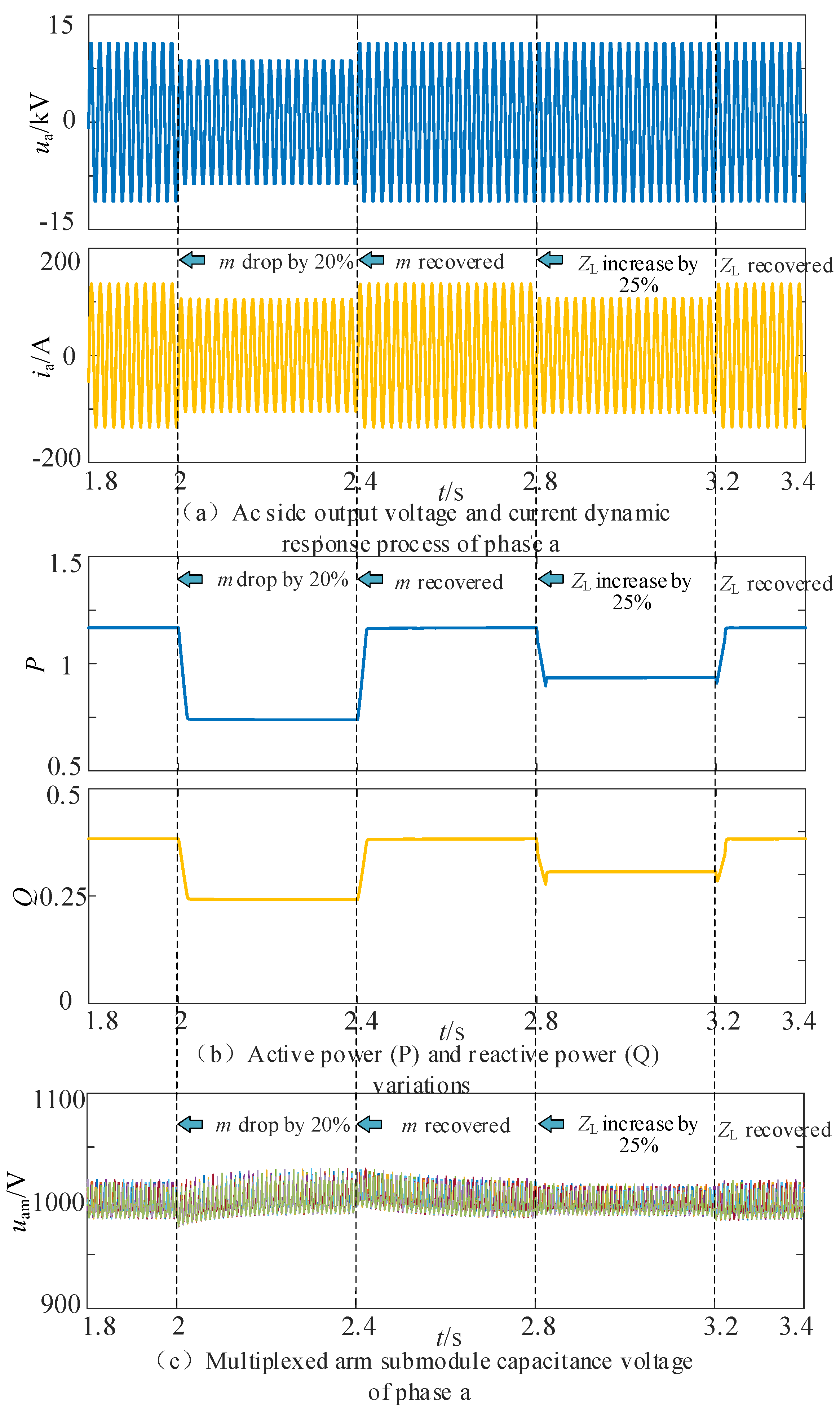
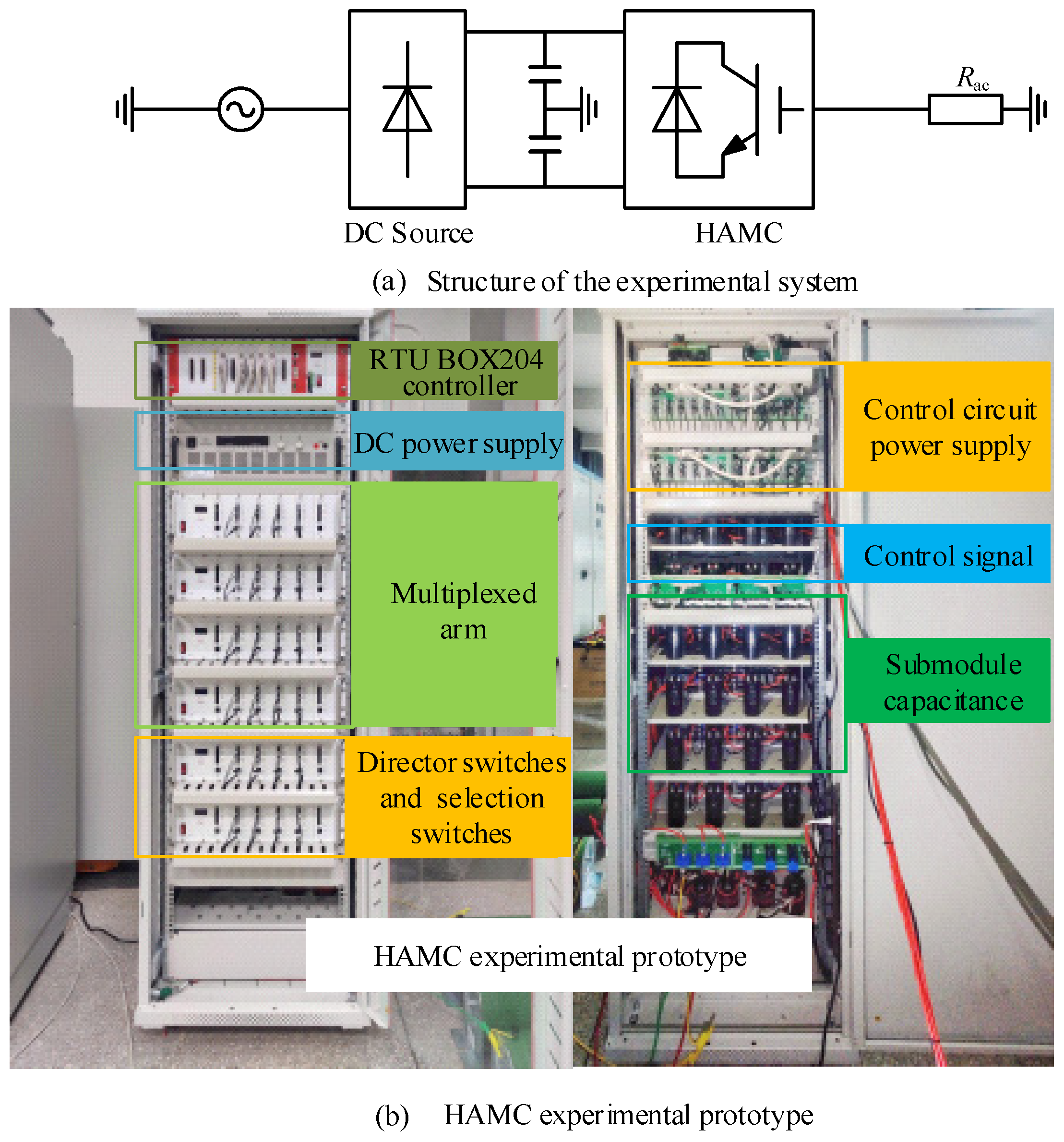
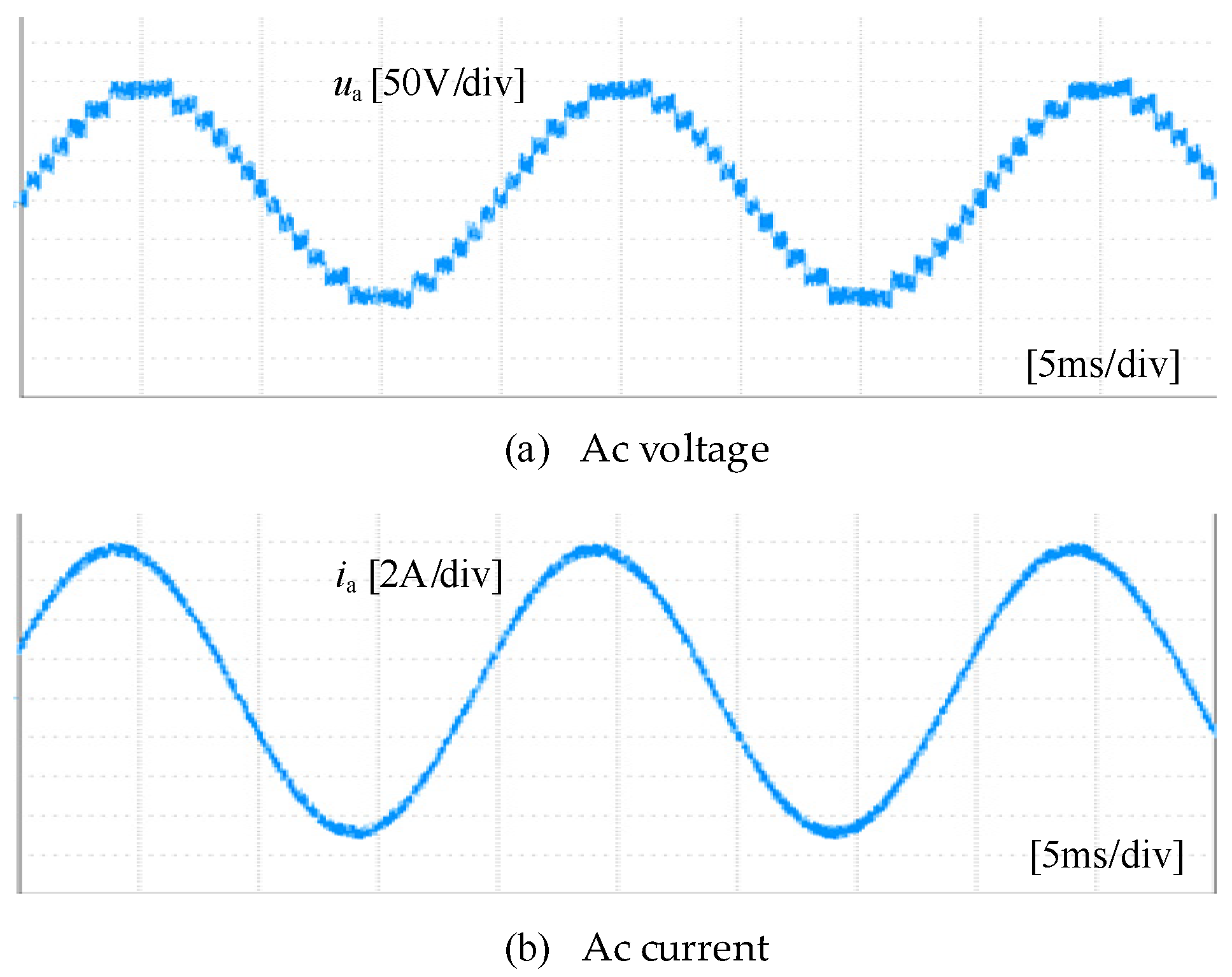
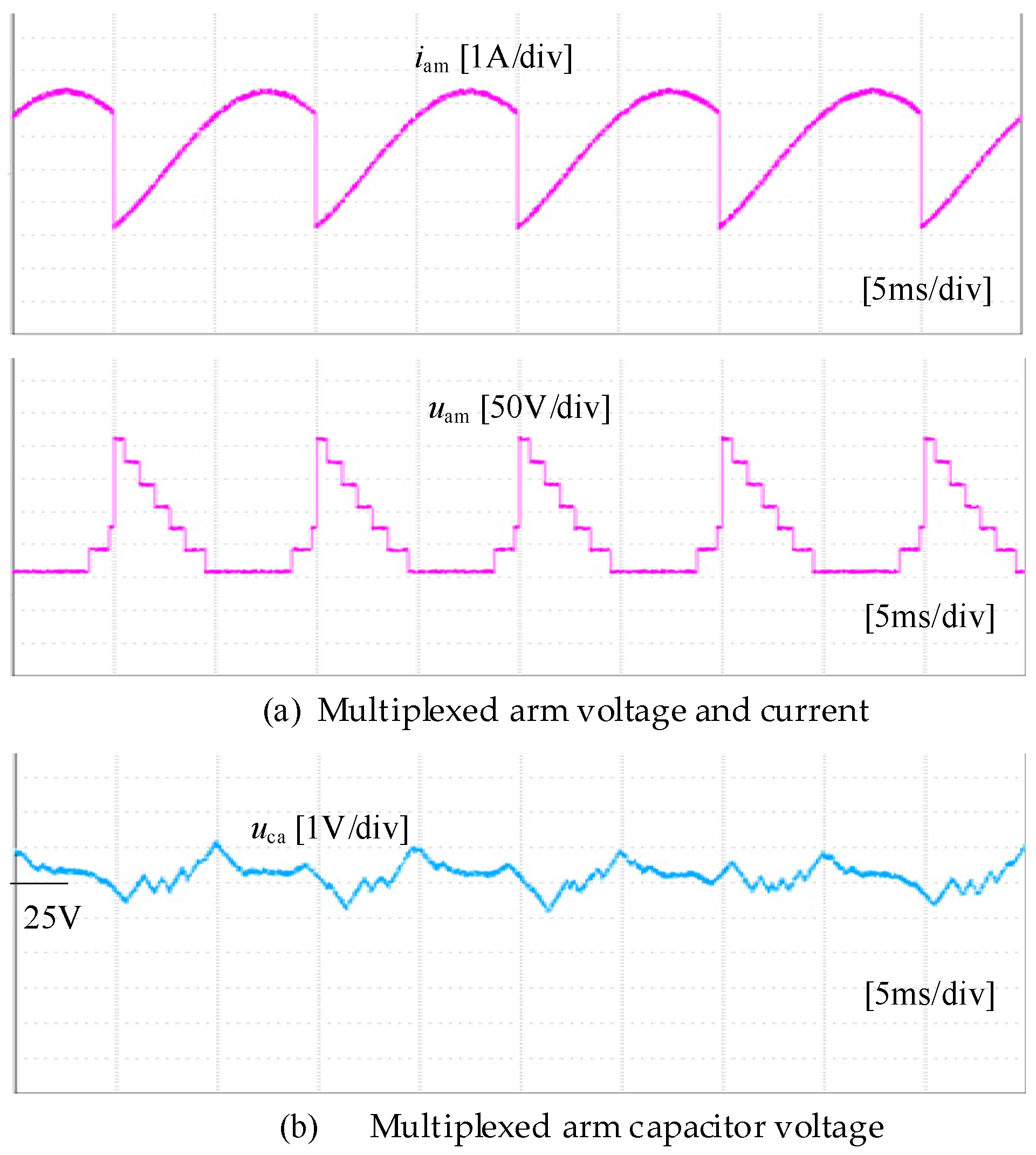
| Parameters | Symbol | Values |
|---|---|---|
| Dc-link voltage | Udc | 20 kV |
| Number of SMs per phase | N | 10 |
| SM capacitor | C | 3 mF |
| SM capacitor reference voltage | Uc | 1 kV |
| Load resistance | Rload | 84 Ω |
| Power factor | cosφ | 0.95 |
| Control Strategy | Device | Conduction Loss/% | Switching Loss/% | Operating Loss/% |
|---|---|---|---|---|
| HPSM | SM | 0.7980 | 0.0594 | 0.8574 |
| DS | 0.4232 | 0.0037 | 0.4269 | |
| SS | 0.2143 | 0.0041 | 0.2184 | |
| Total | 1.4265 | 0.0672 | 1.4937 | |
| THCI | SM | 1.0016 | 0.0430 | 1.0446 |
| DS | 0.6496 | 0.0132 | 0.6628 | |
| SS | 0.5770 | 0.0102 | 0.5872 | |
| Total | 2.2282 | 0.0288 | 2.2946 |
| m | η/° | λ | Phase Voltage THD/% | |
|---|---|---|---|---|
| THCI | HPSM | |||
| 0.7 | −40.3 | 1.284 | 5.79 | 5.20 |
| 0.8 | −35.2 | 1.060 | 5.15 | 4.59 |
| 0.9 | −29.60 | 0.836 | 4.51 | 4.00 |
| 1.0 | −23.50 | 0.623 | 4.08 | 3.65 |
| 1.1 | −16.65 | 0.389 | 3.97 | 3.23 |
| Symbol | HPSM | THCI |
|---|---|---|
| m | [0, 4/π] | [0, 4/π] |
| THD | Low | Low |
| Control complexity | High | Low |
| Operating loss | Low | High |
| Parameters | Symbol | Values |
|---|---|---|
| Rated active power | PN | 2.75 kW |
| Rated frequency | fN | 50 Hz |
| Control circle | Tc | 0.05 ms |
| DC bus voltage | Udc | 300 V |
| Number of SMs per phase | N | 6 |
| SM capacitor | C | 4.34 mF |
| SM capacitor reference voltage | Uc | 1 kV |
| AC Load resistance | Rload | 10 Ω |
| Voltage modulation ratio | m | 0.9 |
Disclaimer/Publisher’s Note: The statements, opinions and data contained in all publications are solely those of the individual author(s) and contributor(s) and not of MDPI and/or the editor(s). MDPI and/or the editor(s) disclaim responsibility for any injury to people or property resulting from any ideas, methods, instructions or products referred to in the content. |
© 2024 by the authors. Licensee MDPI, Basel, Switzerland. This article is an open access article distributed under the terms and conditions of the Creative Commons Attribution (CC BY) license (https://creativecommons.org/licenses/by/4.0/).
Share and Cite
Ma, J.; Peng, Y.; Su, Z.; Gu, Y.; Ni, Q.; Yang, Y.; Wang, Y.; Liu, J. Half-Wave Phase Shift Modulation for Hybrid Modular Multilevel Converter with Wide-Range Operation. Electronics 2024, 13, 3556. https://doi.org/10.3390/electronics13173556
Ma J, Peng Y, Su Z, Gu Y, Ni Q, Yang Y, Wang Y, Liu J. Half-Wave Phase Shift Modulation for Hybrid Modular Multilevel Converter with Wide-Range Operation. Electronics. 2024; 13(17):3556. https://doi.org/10.3390/electronics13173556
Chicago/Turabian StyleMa, Junchao, Yan Peng, Zimeng Su, Yilei Gu, Qiulong Ni, Ying Yang, Yi Wang, and Jianing Liu. 2024. "Half-Wave Phase Shift Modulation for Hybrid Modular Multilevel Converter with Wide-Range Operation" Electronics 13, no. 17: 3556. https://doi.org/10.3390/electronics13173556






